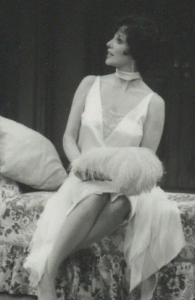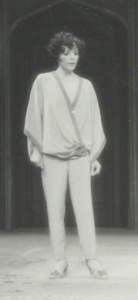
Over a series of posts, I’ll be exploring the casting of a handful of Hollywood actresses who have performed at Chichester Festival Theatre, including Ingrid Bergman, Lauren Bacall, Joan Collins and Kim Cattrall. There is something of an air of mystery about a Hollywood star; how watching their screen performance is as close as us mere mortals could ever get. And yet, we must remind ourselves those immortal stars of the silver screen are indeed, real-life actors and actresses, and a thespian’s true calling removes all cameras and puts them onto a stage. A thrust stage, to be precise.
Joan Collins comes to Chichester
Joan Collins starred as Mrs. Cheyney in The Last of Mrs. Cheyney, the first production of the 1980 Summer Season, which also included Terra Nova, Much Ado About Nothing, and Old Heads and Young Heart. She was no stranger to the stage, having performed in the West End as a young girl since 1946 before heading to America to make her mark in Hollywood (although, of course, it was the television show Dynasty that she is most remembered for) [1].
It was Duncan Weldon, Artistic Director from 1995-1997 who suggested the idea of casting Joan Collins to the then Artistic Director, Peter Dews. This would be Collins’ return to the British stage and as Kate Mosse describes, “It was a coup to have her in Chichester and she was perfectly cast in Lonsdale’s romantic comedy about a jewel thief who passes herself off as a society lady… Although RADA trained, Joan Collins was Hollywood royalty, the sultry star of films such as The Stud and The Bitch.”[2]
She was signed by 20th Century Fox in 1955 as their answer to MGM’s Elizabeth Taylor, an understandable choice; a British brunette beauty, Collins developed her glamorous style throughout her career and even received advice from Marilyn Monroe’s make-up artist Allan Snyder. [3] It was rare to see her stripped of such glamour, both onscreen and off and those hoping to see the star exposed as her ‘real-life’ self would have been disappointed in seeing The Last of Mrs Cheyney. Her role as the jewel thief posing as the social elite meant a costume as glamorous and as diva-ish as the actress herself. Indeed, the costumes were designed by Art-Deco extraordinaire, Erté.

It was wonderful to hear then, as part of our Oral History collection, a remembrance of Joan Collins’ time spent at Chichester Festival Theatre by Stage Door keeper Jan Saunders:
“I have to say, one of the people that I greatly admire has always been Joan Collins…and she was a lovely person, she really was nice…she used to come in for rehearsals and always have a cup of coffee and everything and stand there chatting and then go off to get ready…So that was one of the nicest things… and I’ve seen Joan Collins at half past nine in the morning with no make-up on, and I think that might be a first for a lot of people!”
Finance Director of Chichester Festival Theatre, Simon Parsonage, also remembers Joan Collins’ performance:
“Well, she was a bit of a sex symbol…notorious for doing two films which were heavily X-rated and for doing these various horror B movies that became a bit of a cult later on. To see her on stage doing a proper theatrical production…it showed that she was actually, genuinely, a quality actress and to be fair she went on to prove that when she did Dynasty. As a teenager growing up that wasn’t necessarily what you remembered her for, but you know, she was very good and I saw her in a different light after that production.”
Although the reviews of The Last of Mrs Cheyney weren’t particularly generous, stating “This play moves from one melodrama to another…these are just for the proverbial tired businessman and that only if he is very tired and business is unusually bad” Collins herself was praised for her performance and undoubtedly, because of her celebrity, the production did very well at the box office and later transferred to sold-out performances in the West End at the Cambridge Theatre.[4]
[2] Chichester Festival Theatre at Fifty, Mosse, Kate. P. 86.
[4] Chichester Festival Theatre at Fifty, Mosse, Kate. P. 86.


